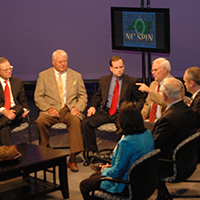State Board of Ed wants to get it right on charter schools report
Published January 10, 2016
by Lee Teague, NC Charter Schools Association, Jones and Blount, January 8, 2016.
We live in a world where the “hurry up, get-it-done mentality” sometimes leads to poor analysis and actions. Sometimes taking the time to make a thorough review is the right thing to do. Such was the case this week when the State Board of Education decided to wait a month to approve an annual report on charter schools to the General Assembly, despite having to miss a deadline.
The first draft of the report was not provided to the SBE until two days before the meeting. Typically, it would take a month to review such a report, not “Action on First Reading.” It was not produced in time for the Charter School Advisory Board to review it. Despite weeks of requests, charter advocates did not see it until the morning of the meeting. Why the draft report was held back is unknown, but it was.
As a charter advocate, I have several concerns with this draft, but let me address two that made the Charlotte Observer newspaper this week.
First, there is the charge that charter students are much wealthier than traditional school students. The report states 55 percent of traditional students come from economically disadvantaged families, while only 36 percent of charter students do. The problem here is the old “garbage in, garbage out” phenomenon. Many charters do not participate in the federal Free and Reduced Lunch programs so are not required to collect income data. Many try to self-report, but underestimate to be on the safe side. Seven schools did not report at all. This data is not reliable enough to make a solid determination on whether charter students are wealthier or not. Charter advocates have been complaining about this for years.
Second, the report does say charters have a higher percentage of white students and a lower percentage of Hispanic students than traditional schools. Black students and all other ethnic groups are about the same. What the report later said – which was not mentioned in the press – is “there is no mechanism by which schools can guarantee racial and ethnic balance.” Charter students are chosen by a lottery of those who apply. Charters are open to any student eligible to attend traditional schools and the schools cannot pick and choose which ones.
However, the report compares statewide numbers. Traditional schools are well distributed geographically by student population. The state’s 158 charters are not. There are many charters in urban areas. Some rural counties have several large charter schools, some one small charter, some have no charter schools at all. Wouldn’t the data be more useful if we made the comparison to the relevant local school districts rather than the entire state?
At the instigation of Lt. Gov. Dan Forest, the SBE decided not to rush this report. Getting it right was more important than getting it done.
There are two facts in the draft report which no one disputes. Nearly half of charters received an A or B School Performance Grade, while slightly less than 30 percent of traditional schools did. Fully 62 percent of charter schools exceeded the composite performance in Grade Level Proficiency of their home school district. There is always room for improvement, but charters are providing our children with quality education.







